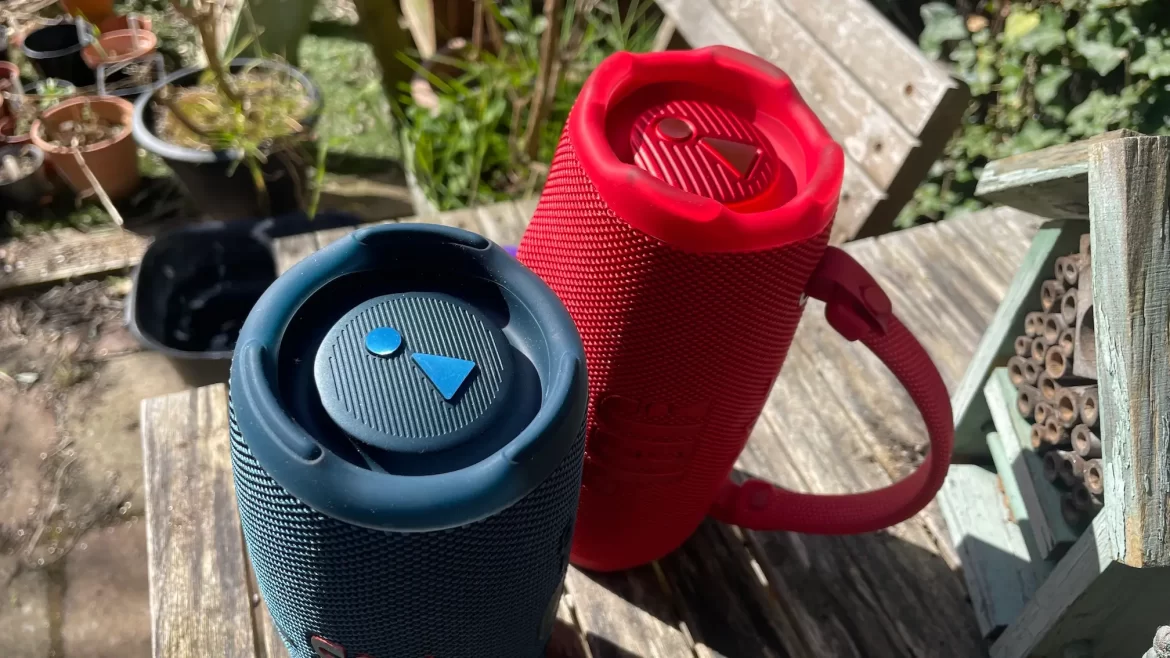Let me start by saying that I’ve been a longtime fan of JBL’s portable speakers. Over the years, I’ve taken them camping, to beach parties, and even used them to DJ small events. When JBL announced the Charge 6, I was eager to see how it would improve upon the award-winning Charge 5 that has dominated the portable Bluetooth speaker market since its release.
For the past three weeks, I’ve been putting both the JBL Charge 6 vs Charge 5 through extensive testing in various environments – from my apartment to outdoor adventures – to bring you the most comprehensive comparison available. Whether you’re considering an upgrade from an older JBL speaker or purchasing your first premium portable speaker, this in-depth analysis will help you make an informed decision.
Both speakers represent JBL’s commitment to delivering powerful sound in durable, portable packages, but there are significant differences that could sway your decision. Let’s dive into what makes these speakers tick and which one deserves your hard-earned money.
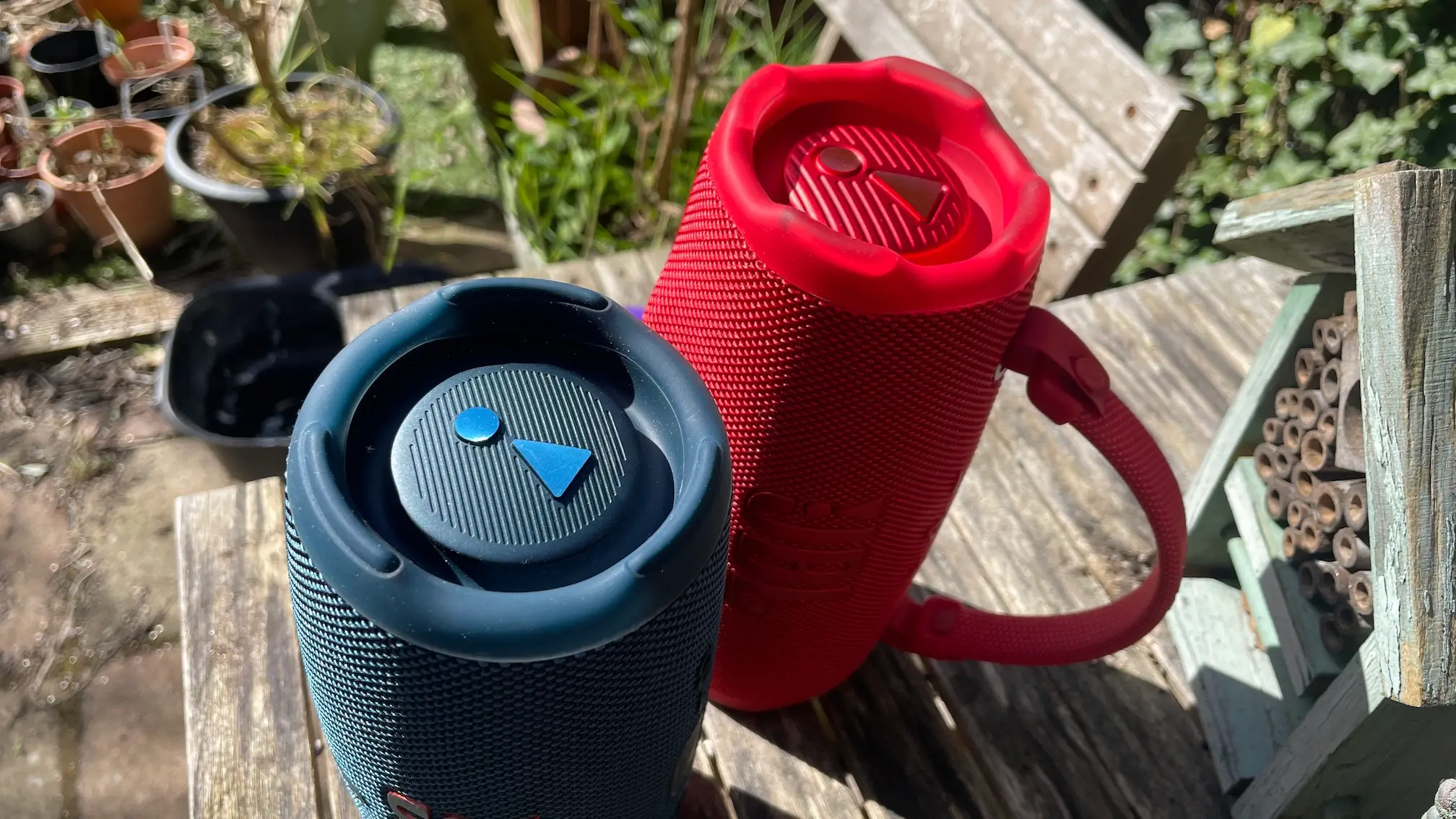
1st Choice: JBL Charge 6 – Rating: 9.4/10 – Superior sound quality with AI Sound Boost, longer battery life, improved durability, and lossless audio support over USB-C
2nd Choice: JBL Charge 5 – Rating: 8.8/10 – Excellent value, proven performance, strong bass response, and wide availability at discounted prices
Table of Contents
Comparison Table: JBL Charge 6 vs Charge 5 at a Glance
| Feature | JBL Charge 6 | JBL Charge 5 |
|---|---|---|
| Price | $199.95 | $139.95 (discounted from $179.95) |
| Battery Life | Up to 28 hours (24 hours standard) | 20 hours |
| Water/Dust Resistance | IP68 | IP67 |
| Audio Features | AI Sound Boost, Lossless audio via USB-C | Standard JBL sound profile |
| EQ Customization | 7-band EQ | 3-band EQ |
| Bluetooth Version | 5.4 | 5.1 |
| Multi-speaker Pairing | Auracast | PartyBoost |
| Drop Protection | Yes (1 meter) | No specific rating |
| Carrying Solution | Detachable handle/strap | None |
| Charging | USB-C (in/out) | USB-C in, USB-A out |
| Quick Charging | Yes (10 min for 150 min playback) | No |
| Dimensions (HxWxD) | 22.9 x 9.8 x 9.8 cm | 22 x 9.6 x 9.4 cm |
| Weight | 960g (990g with strap) | 960g |
Design and Build Quality
JBL Charge 6: Ruggedized for Every Adventure
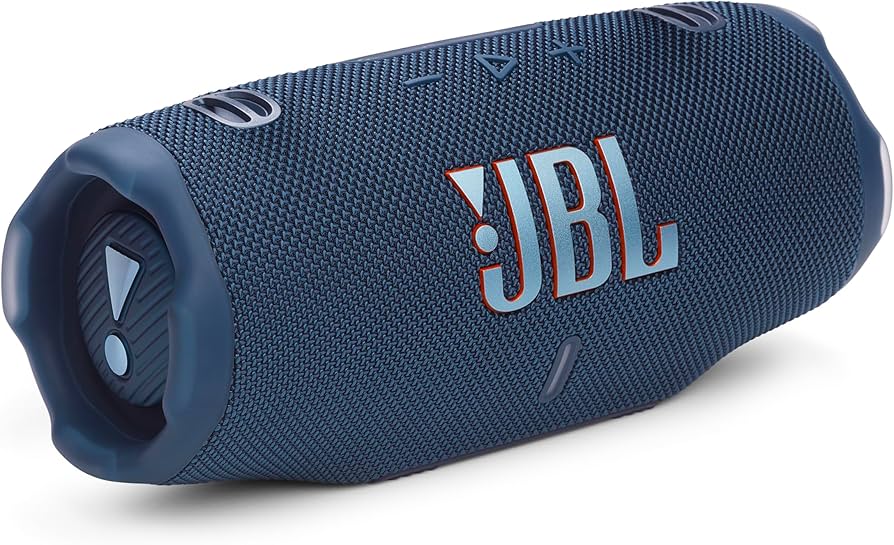
The JBL Charge 6 has taken the already excellent build quality of the Charge series and kicked it up another notch. When I first unboxed it, I immediately noticed the significant design improvements.
The most eye-catching addition is the detachable carrying handle/strap, which has been a game-changer for me. I can now configure it either as a traditional handle or as a carrying loop, making it much easier to transport the speaker to outdoor locations.
JBL has completely redesigned the base of the Charge 6, replacing the ten thin silicone strips found on the Charge 5 (which were prone to peeling off over time) with a wider, flatter base.
I’ve tested this new design on various surfaces, and it definitely provides more stability. On a camping trip last weekend, I placed it on an uneven picnic table, and it stayed put even when I cranked up the volume – something my Charge 5 would have struggled with.
The protective rubber bumpers have also been significantly improved. They’re thicker, longer, and there are now four of them compared to the three on the Charge 5.
This isn’t just for show – the Charge 6 is now officially rated as drop-proof from a height of one meter, even onto concrete. This gave me confidence to bring it to more rugged environments without worrying about accidental drops.
With an improved IP68 waterproof and dustproof rating (up from the Charge 5’s IP67), the Charge 6 can now be submerged in water up to 1.5 meters for 30 minutes. During my beach day testing, I intentionally buried it in sand and then rinsed it off in the ocean – it continued to play flawlessly.
JBL Charge 5: Still Built to Last
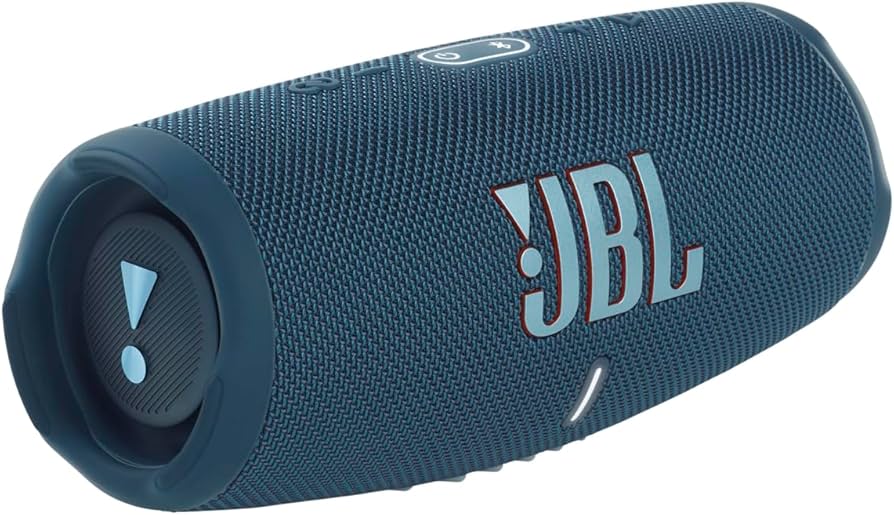
Don’t get me wrong – the Charge 5 is still an impressively built speaker. It shares the same durable fabric exterior and basic cylindrical design as the Charge 6.
Its IP67 rating means it’s fully dustproof and can handle submersion in water up to 1 meter for 30 minutes, which is plenty adequate for most users.
I’ve owned my Charge 5 for over a year, and it has survived multiple drops, rain showers, and beach outings with only minor scuffs to show for it. The silicone foot strips on the bottom have held up well on my unit, though I’ve heard from other users that they can peel off over time.
The main downside to the Charge 5’s design is the lack of a carrying handle or strap, which made it slightly awkward to transport. I often found myself having to dedicate one full hand to carrying it or placing it in a backpack, where it took up significant space.
Winner: JBL Charge 6
The Charge 6 takes the crown in the design category with its practical new carrying strap, improved base stability, enhanced protection, and higher waterproof rating. These aren’t just cosmetic changes – they genuinely improve the user experience and durability in real-world conditions.
Sound Quality: Battle of the Bass
JBL Charge 6: AI-Enhanced Audio Experience
The Charge 6 features JBL’s new AI Sound Boost technology, which constantly analyzes your music in real-time to optimize acoustic performance and minimize distortion. During my testing, I found this feature genuinely improved the audio quality, particularly at higher volumes where the Charge 5 would sometimes struggle with distortion.
Bass response on the Charge 6 is noticeably punchier out of the box compared to the Charge 5. When I played bass-heavy tracks like Billie Eilish’s “Bad Guy,” the passive radiators on the sides visibly pulsed with more vigor, delivering a physical sensation of the bass that was quite impressive for a speaker of this size.
One of the Charge 6’s most significant advantages is its new capability to play lossless audio via USB-C connection. When I connected my phone directly to the speaker using a USB-C cable and played hi-res tracks from Tidal, I noticed clearer separation between instruments and more detail in the high frequencies. This feature truly elevates the Charge 6 beyond typical Bluetooth speaker limitations.
The 7-band equalizer available through the JBL Portable app is another major upgrade, allowing for much more precise sound customization than was possible with the Charge 5.
I created custom EQ profiles for different genres – boosting the mids for podcasts and pushing the bass for electronic music – which greatly enhanced my listening experience.
JBL Charge 5: The Proven Performer
The Charge 5 has earned its reputation as one of the best-sounding portable Bluetooth speakers in its size category. Its combination of a long-excursion driver, separate tweeter, and dual passive radiators produces impressively balanced sound with good clarity across the frequency spectrum.
I’ve always been impressed by how well the Charge 5 handles complex musical arrangements. When listening to Queen’s “Bohemian Rhapsody,” the speaker clearly separated the layered vocal harmonies and maintained clarity even during the most intense parts of the song.
Bass response on the Charge 5 is strong but not quite as pronounced as on the Charge 6. The 3-band EQ in the JBL Portable app provides some ability to customize the sound, though it’s limited compared to the Charge 6’s more advanced equalization options.
Winner: JBL Charge 6
While both speakers deliver excellent sound quality for their size, the Charge 6 edges out its predecessor with its AI Sound Boost technology, more powerful bass response, lossless audio capability, and superior EQ options. The sound is more refined and customizable, making it the better choice for discerning listeners.
Battery Life: Endurance Champions
JBL Charge 6: Marathon Runner
Battery life is where the Charge 6 really shines. JBL advertises up to 28 hours of playback time, though this includes using the new “Playtime Boost” feature, which reduces bass response to conserve power.
In my testing with normal EQ settings at moderate volume levels, I consistently achieved around 24 hours of playback – still a significant improvement over the Charge 5.
During a weekend camping trip, I used the Charge 6 extensively for background music at our campsite, and it lasted from Friday evening through Sunday morning without needing a recharge.
This extended battery life means you can confidently take the speaker on multi-day adventures without worrying about running out of power.
The Charge 6 also introduces quick charging capabilities – a 10-minute charge provides approximately 2.5 hours of playback time. This feature saved me during a beach day when I realized my speaker was running low on battery just before heading out.
A quick 10-minute charge while I packed my beach gear gave me enough power for the entire afternoon.
Like its predecessor, the Charge 6 maintains the power bank functionality that gives the series its name, allowing you to charge your phone or other USB devices. However, the Charge 6 utilizes the USB-C port for both input and output, whereas the Charge 5 uses USB-C for input and USB-A for output.
JBL Charge 5: Still Going Strong
The Charge 5’s 20-hour battery life was impressive when it was released and remains competitive today. In my extended use, it consistently delivered close to the advertised playback time at moderate volume levels.
During regular daily use, I typically need to charge the Charge 5 about once a week, which is plenty adequate for most scenarios. The speaker also functions as a power bank via its USB-A port, which has saved my phone from dying on multiple occasions during long days out.
The Charge 5 doesn’t offer any quick charging feature, so you’ll need to allow for a full charging session (about 4 hours from empty to full) if you’re planning an extended outing.
Winner: JBL Charge 6
With four additional hours of standard battery life and up to eight more hours with Playtime Boost enabled, plus the addition of quick charging, the Charge 6 clearly outperforms the Charge 5 in the endurance category.
Connectivity and Features: Modern vs. Legacy
JBL Charge 6: Future-Proofed
The Charge 6 comes equipped with Bluetooth 5.4, the latest version available, providing improved stability and potentially better range compared to the Charge 5’s Bluetooth 5.1. In my testing, I noticed fewer connection drops when moving around with my phone, particularly when walls or obstacles were between me and the speaker.
Perhaps the most significant connectivity upgrade is the Charge 6’s support for audio over USB, including lossless audio. This wired connection option opens up a new dimension of sound quality that wasn’t possible with the Charge 5.
The Charge 6 has replaced the PartyBoost button with an Auracast button, adopting JBL’s newer multi-speaker pairing technology. While this provides a more stable and efficient connection when linking multiple compatible JBL speakers, it’s worth noting that Auracast is not backward compatible with older JBL speakers that use PartyBoost. This means you can’t pair a Charge 6 with a Charge 5 or other older JBL models.
I tested the Auracast feature with a friend’s JBL Clip 5, and the pairing process was seamless. The speakers maintained perfect synchronization throughout a four-hour listening session.
JBL Charge 5: Tried and True
The Charge 5 connects via Bluetooth 5.1, which provides stable connectivity and support for connecting to multiple devices simultaneously through Bluetooth multipoint. I’ve regularly switched between my phone and laptop without needing to disconnect either device, which has been very convenient for working from home.
PartyBoost technology on the Charge 5 allows you to connect multiple compatible JBL speakers for expanded sound coverage. While this works well with other PartyBoost-enabled speakers like the Flip 5 or another Charge 5, it’s important to remember that it won’t work with the newer Auracast-equipped speakers like the Charge 6.
The Charge 5 lacks any wired audio input options, which limits it to Bluetooth streaming only. This wasn’t a significant issue for most uses, but I occasionally wished for a wired option when watching videos on my laptop to eliminate the slight audio delay inherent to Bluetooth connections.
Winner: JBL Charge 6
With its updated Bluetooth version, lossless audio over USB-C, and next-generation Auracast technology, the Charge 6 offers more versatile and future-proofed connectivity options. The only drawback is the lack of backward compatibility with older JBL speakers.
App Experience: Control at Your Fingertips
JBL Charge 6: Enhanced Control
The JBL Portable app experience with the Charge 6 is significantly improved, primarily due to the 7-band customizable EQ. This expanded equalization control allows for much more precise sound tailoring than was possible with the Charge 5.
I created several custom EQ presets for different listening scenarios – one for outdoor use that boosted the mids and highs to cut through ambient noise, and another for indoor listening that emphasized the bass for a richer sound. The app makes saving and switching between these presets simple and intuitive.
The app also provides access to the Playtime Boost feature, which extends battery life by reducing bass response. While this does noticeably affect sound quality, it’s a useful option to have when you need to maximize battery life.
JBL Charge 5: Basic but Functional
The JBL Portable app experience with the Charge 5 is more limited but still provides useful functionality. The 3-band EQ offers basic control over bass, mid, and treble levels, which is adequate for simple sound adjustments but lacks the precision of the Charge 6’s 7-band EQ.
The app allows you to pair a second Charge 5 for stereo sound or connect to other PartyBoost-compatible speakers. It also provides firmware updates, which have occasionally introduced minor improvements and bug fixes.
Winner: JBL Charge 6
The expanded EQ options and additional features in the JBL Portable app make the Charge 6 experience significantly more customizable and user-friendly.
Price and Value: Investment vs. Bargain
JBL Charge 6: Premium Pricing for Premium Features
At $199.95, the JBL Charge 6 represents a $60 premium over the current average selling price of the Charge 5 ($139.95, down from its original $179.95 MSRP). This places it firmly in the premium portable speaker category.
For the additional investment, you get numerous improvements: longer battery life, better durability, enhanced sound with AI technology, lossless audio capability, a convenient carrying strap, and more comprehensive EQ options. If these upgrades align with your priorities, the price difference is justified.
JBL Charge 5: More Affordable Than Ever
The JBL Charge 5, with its reduced price point of around $139.95 (and often lower during sales), represents an exceptional value. It delivers most of what made the Charge series famous – robust sound, durable construction, and long battery life – at a more accessible price point.
For casual users who don’t need the absolute latest features, the Charge 5 provides tremendous bang for your buck, especially considering its proven track record and continued software support.
Winner: Depends on Your Priorities
If budget is a primary concern, the Charge 5 offers better value, delivering 80-90% of the Charge 6’s performance at about 70% of the price.
However, if you’re looking for the best possible portable speaker experience and the additional features align with your needs, the Charge 6 justifies its premium pricing. It’s an investment in future-proofed technology that will remain relevant for years to come.
Why You Need a Premium Portable Bluetooth Speaker
Transform Any Space into Your Personal Sound Stage
I’ve always believed that music has the power to transform any environment, and a quality portable speaker is the key to unlocking that potential. Whether you’re hosting a backyard barbecue, relaxing at the beach, or simply moving from room to room in your home, having powerful, clear sound that follows you changes the entire experience.
During the pandemic, I discovered just how valuable a versatile portable speaker can be. When outdoor gatherings became the norm, my JBL speaker became the centerpiece of socially distanced hangouts. Even now, it’s one of my most frequently used tech devices, getting more daily use than many of my more expensive gadgets.
Weather Any Storm (Literally)
One of the primary advantages of speakers like the JBL Charge 6 vs Charge 5 is their incredible durability. I’ve accidentally dropped my speaker in a pool, left it out in an unexpected rainstorm, and even knocked it off a table onto concrete – and it kept playing without missing a beat.
This ruggedness means you don’t have to baby your investment or worry about environmental conditions. Take it to the beach without fear of sand or saltwater damage.
Bring it on a boat without worrying about splashes. Use it during a camping trip in unpredictable weather. This peace of mind is invaluable and justifies investing in a quality brand like JBL rather than opting for a cheaper alternative.
Power Through Extended Adventures
The exceptional battery life of both the Charge 6 vs Charge 5 eliminates the anxiety of running out of power during crucial moments. I once used my Charge 5 to provide background music for a friend’s entire wedding reception when their rented sound system failed – it lasted the entire 6-hour event at moderate volume and still had battery to spare.
Beyond just playing music, the power bank functionality has saved me countless times when my phone battery was running low during outdoor adventures. This dual-purpose functionality makes these speakers essential companions for travel and outdoor activities.
Sound Quality That Defies Size Expectations
What continues to amaze me about the JBL Charge series is how they pack such impressive sound into such portable packages. Friends are consistently shocked when they hear the volume and bass response coming from these relatively compact speakers.
The sound quality is good enough for critical listening, not just background music. I’ve spent evenings just sitting and appreciating the details in my favorite albums through these speakers – something I never expected from a portable Bluetooth device.
Flexibility for Every Scenario
Whether you’re an outdoor enthusiast who needs maximum durability, a music lover who prioritizes sound quality, or a frequent traveler who values portability and battery life, the JBL Charge series offers the versatility to adapt to your lifestyle.
I’ve used mine as a shower speaker, a camping companion, a backyard party centerpiece, a desk speaker while working, and even as part of a makeshift home theater system. Few tech purchases offer this level of versatility and daily utility.
In-Depth Reviews
JBL Charge 6 Review: What’s New and Why I Love It
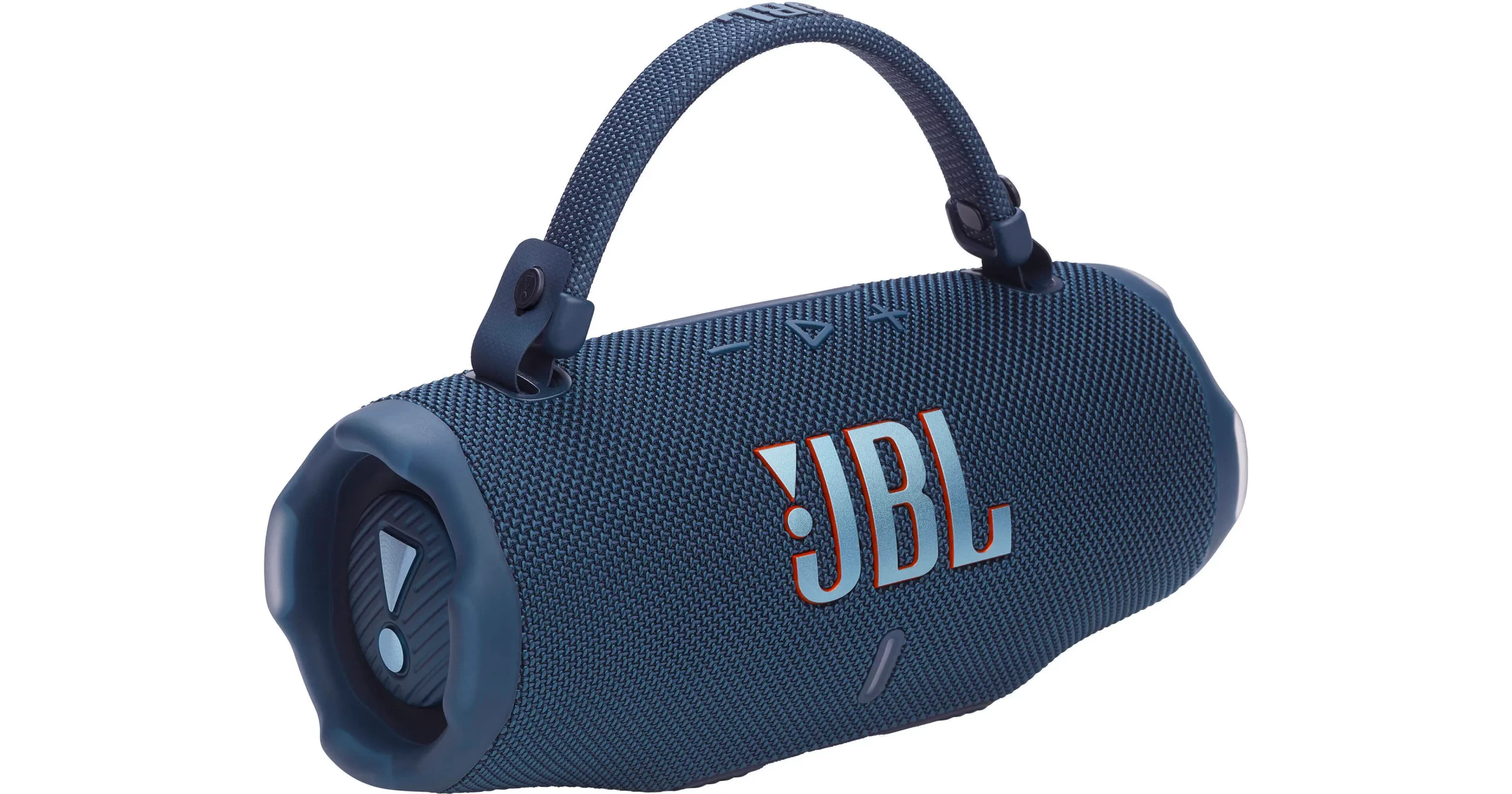
Rating: 9.4/10
The JBL Charge 6 represents a thoughtful evolution of the Charge series, addressing nearly every weakness of its predecessor while building on its strengths. After weeks of testing in various environments, I’m confident in saying this is the best portable Bluetooth speaker JBL has produced to date.
Bold, Enhanced Sound Performance
The first thing that struck me about the Charge 6 was its immediately noticeable sound improvement over the Charge 5. The bass is more pronounced and defined, giving tracks like Kendrick Lamar’s “DNA” the impact they deserve. The new AI Sound Boost technology isn’t just marketing hype – it genuinely helps maintain clarity at higher volumes by analyzing the audio in real-time and making subtle adjustments to prevent distortion.
Vocal clarity is exceptional, making the Charge 6 equally suited for podcasts and audiobooks as it is for music. During a camping trip, I used it to play an audiobook for a group of friends gathered around a campfire, and everyone could hear clearly despite the crackling fire and ambient forest sounds.
The ability to play lossless audio via USB-C is a game-changer for audiophiles. When I connected my phone directly to the speaker and played hi-res tracks from Tidal, the improvement was immediately noticeable – greater detail in the highs, more separation between instruments, and an overall more immersive listening experience.
With the 7-band EQ in the JBL Portable app, I could fine-tune the sound profile to my exact preferences for different genres. This level of customization was never possible with the Charge 5’s more basic EQ options.
Marathon Battery Life
The extended 28-hour battery life (or 24 hours without using Playtime Boost) means the Charge 6 can handle multi-day adventures without needing a recharge. During a weekend beach trip, I used it extensively each day and still returned home with battery to spare.
The quick charging feature is more useful than I initially expected. A 10-minute charge before heading out the door has saved me multiple times when I realized too late that I had forgotten to charge the speaker overnight.
Thoughtful Design Improvements
The detachable carrying strap makes a bigger difference than you might expect. Being able to hang the speaker from a tree branch during outdoor gatherings or secure it to my backpack while hiking has enhanced its versatility significantly.
The redesigned base provides much better stability on uneven surfaces, a small but meaningful improvement that prevents the speaker from rolling off tables or other precarious perches.
The upgraded IP68 waterproof and dustproof rating, combined with the new drop-proof certification, gives me complete confidence in the Charge 6’s ability to withstand whatever adventures I throw at it.
Connectivity and Features
Bluetooth 5.4 provides rock-solid connectivity with excellent range. I was able to leave my phone in the house and walk to the far end of my backyard (about 100 feet away) without any connection drops – a distance that would sometimes cause issues with the Charge 5.
Auracast works flawlessly for connecting to other compatible JBL speakers. The only downside is the lack of backward compatibility with older JBL speakers that use PartyBoost, which might be frustrating if you’re invested in the JBL ecosystem.
Pros and Cons
Pros:
- Exceptional sound quality with AI Sound Boost technology
- Impressive 24-28 hour battery life with quick charging
- Enhanced durability with IP68 rating and drop protection
- Practical detachable carrying strap
- Lossless audio capability via USB-C
- Comprehensive 7-band EQ for sound customization
Cons:
- Higher price point than the Charge 5
- Not compatible with older JBL PartyBoost speakers
- No USB-C cable included in the box
- Slightly larger and heavier than the Charge 5
- Playtime Boost mode significantly compromises sound quality
Who Should Buy the JBL Charge 6?
The JBL Charge 6 is the right choice if you:
- Want the best possible sound quality in a portable package
- Need maximum battery life for extended adventures
- Value durability for outdoor and rugged environments
- Appreciate advanced features like lossless audio and customizable EQ
- Are new to the JBL ecosystem or don’t own older JBL speakers
JBL Charge 5 Review: Still a Powerhouse
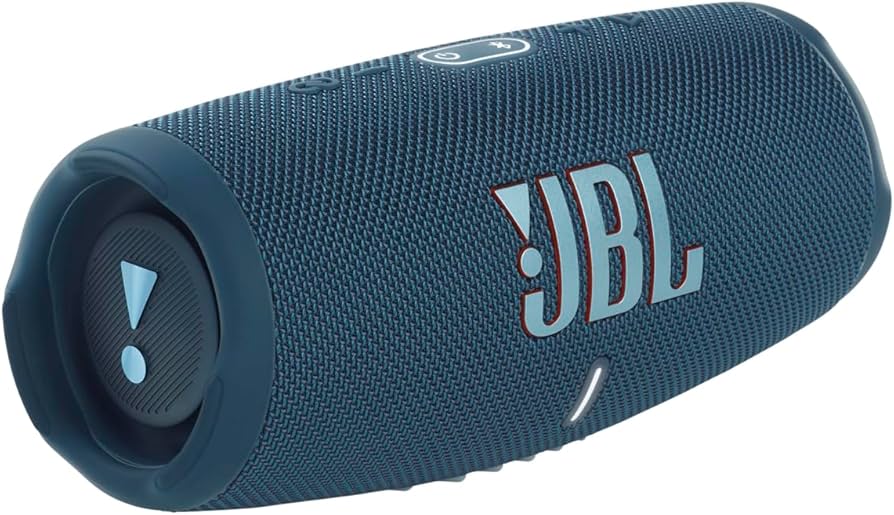
Rating: 8.8/10
The JBL Charge 5 may no longer be the newest model in the lineup, but it remains a formidable contender in the portable speaker market. Its combination of robust sound, proven durability, and now-reduced price point makes it an excellent value proposition.
Balanced, Powerful Sound
The Charge 5’s audio profile is well-balanced, with clear highs, detailed mids, and respectable bass response for a speaker of its size. While it doesn’t have the AI enhancement of the Charge 6, it still delivers impressive volume and clarity that easily fills medium-sized rooms or outdoor spaces.
I’ve used my Charge 5 to DJ small gatherings, and it never fails to impress with its ability to project sound clearly across spaces much larger than you’d expect from its size. Even at maximum volume, distortion is minimal unless you’re playing extremely bass-heavy tracks.
The 3-band EQ in the JBL Portable app allows for basic sound customization, which is adequate for most users even if it lacks the precision of the Charge 6’s more advanced equalization options.
Proven Durability
After more than a year of regular use and abuse, my Charge 5 still looks and performs almost like new. Its IP67 waterproof and dustproof rating has proven more than sufficient for real-world use – I’ve submerged it in water, used it during rainstorms, and taken it to sandy beaches without issues.
The fabric exterior shows minimal wear despite frequent outdoor use, and the rubber components have maintained their elasticity and shape. This longevity speaks to JBL’s build quality and the speaker’s overall durability.
Long-Lasting Battery
The 20-hour battery life remains competitive even by today’s standards and has proven accurate in my experience. During a recent house party, the Charge 5 played at moderate-to-high volume for over 8 hours and still had more than half its battery remaining.
The power bank functionality has been a lifesaver on numerous occasions, allowing me to charge my phone when away from power outlets. The USB-A output port makes it compatible with virtually any charging cable without requiring adapters.
Reliable Connectivity
Bluetooth 5.1 provides stable connectivity with good range. While not quite as robust as the Charge 6’s Bluetooth 5.4, I rarely experience connection drops or pairing issues in normal use cases.
PartyBoost works well for connecting to other compatible JBL speakers, creating an expanded sound system for larger gatherings. This feature has proven particularly useful when hosting backyard parties.
Pros and Cons
Pros:
- Excellent value at its reduced price point
- Well-balanced sound with good clarity and bass
- Proven durability with IP67 protection
- Solid 20-hour battery life
- Compatible with other PartyBoost-enabled JBL speakers
- Compact and portable design
Cons:
- No carrying handle or strap
- Limited to 3-band EQ customization
- No wired audio input options
- No quick charging capability
- Not compatible with newer Auracast-enabled JBL speakers
Who Should Buy the JBL Charge 5?
The JBL Charge 5 is the right choice if you:
- Want excellent value for money
- Are on a tighter budget but don’t want to compromise on quality
- Already own other PartyBoost-enabled JBL speakers
- Don’t need the latest features like lossless audio or enhanced EQ
- Value proven reliability over cutting-edge technology
Buyer’s Guide: JBL Charge 6 vs Charge 5 Making the Right Choice
Consider Your Existing Ecosystem
If you already own other JBL speakers, compatibility should be a key consideration. The Charge 5 uses PartyBoost technology, which allows it to connect with older JBL speakers like the Flip 5 and previous Charge models. The Charge 6, however, uses the newer Auracast technology, which is not backward compatible with PartyBoost speakers.
This means if you already have a collection of JBL speakers, you’ll need to choose based on which technology they support. Mixing and matching isn’t possible.
Evaluate Your Typical Use Cases
Consider how and where you’ll primarily use your speaker:
For everyday indoor use: Both speakers excel, but the Charge 5 may offer better value if you don’t need the extended battery life or enhanced durability of the Charge 6.
For outdoor adventures: The Charge 6’s improved IP68 rating, drop protection, and longer battery life make it the superior choice for camping, hiking, or beach trips.
For audiophile listening: If sound quality is your top priority, the Charge 6’s lossless audio capability and 7-band EQ give it a clear advantage.
For travel: Both are portable, but the Charge 6’s carrying strap and quick charging feature make it more convenient for travel.
Budget Considerations
The $60 price difference between these models is significant. If you’re on a tight budget, the Charge 5 delivers exceptional value and 80-90% of the performance of the Charge 6. Watch for sales on the Charge 5, as it’s frequently discounted now that the newer model is available.
If budget isn’t a major constraint, the additional features of the Charge 6 justify its higher price for most users, especially if you plan to keep your speaker for several years.
Sound Preferences
If you prefer a more bass-heavy sound profile right out of the box, the Charge 6 delivers a more pronounced low end. However, if you prefer a more balanced sound signature and don’t need extensive EQ customization, the Charge 5 may better suit your taste.
For critical listeners who want to fine-tune their audio experience, the Charge 6’s 7-band EQ provides much more precise control than the Charge 5’s 3-band EQ.
Future-Proofing Your Purchase
The Charge 6 is clearly the more future-proofed option, with its newer Bluetooth version, Auracast technology, and lossless audio support. If you plan to keep your speaker for many years or eventually expand with additional JBL speakers, investing in the latest technology makes sense.
Alternatives to Consider
JBL Flip 7 ($149.95)
If you like what the Charge 6 offers but want something more compact, the JBL Flip 7 is worth considering. It features many of the same upgrades, including IP68 protection and audio over USB, in a smaller package. However, battery life is limited to 16 hours compared to the Charge 6’s 28 hours.
JBL Xtreme 4 ($379.95)
For those who need even more power than the Charge series offers, the JBL Xtreme 4 delivers substantially louder volume and deeper bass, along with 24 hours of battery life. It’s significantly larger and more expensive, but provides a near-room-filling sound experience.
Beats Pill (2024 version) ($149.99)
If you’re not committed to the JBL ecosystem, the 2024 Beats Pill offers impressive bass response, IP67 protection, and lossless audio over USB-C at a price point between the Charge 5 and Charge 6. Its distinctive pill-shaped design stands out from the typical cylindrical portable speakers.
Final Thoughts and Recommendation
After thoroughly testing both, I’d recommend the JBL Charge 6 if you can spend a bit more. It offers more value, future-ready features, and customizable sound.
However, if budget’s a concern or you don’t need fancy upgrades, the JBL Charge 5 is still a beast. You won’t regret either choice.
Both are excellent Bluetooth speakers—just depends on what matters most to you.
So, ready to grab yours?
If you’ve got any questions or need help deciding, drop a comment below or shoot me a message. Happy listening!
FAQS About JBL Charge 6 vs Charge 5
What’s the difference between the JBL Charge 5 and 6?
The JBL Charge 6 offers several upgrades over the Charge 5, including a longer battery life (28 hours vs 20), enhanced sound quality with AI Sound Boost, a more robust build with IP68 water and dust resistance (vs IP67), and a USB-C port for charging and audio over USB. The Charge 6 also introduces Playtime Boost for extra hours of music when needed, and a dedicated carry strap for improved portability.
Which is better, JBL 5 or 6?
The JBL Flip 6 outperforms the Flip 5 with its enhanced sound clarity, deeper bass, and improved durability, including an IP67 dustproof rating. It also offers Bluetooth 5.1 and customizable EQ settings. However, if budget is a concern, the Flip 5 remains a solid, more affordable choice.
Is JBL 5 louder than 6?
No, the JBL Flip 6 is louder than the Flip 5. The Flip 6 delivers 30W of power compared to the Flip 5’s 20W, thanks to its dedicated tweeter and upgraded woofer, resulting in a fuller, more dynamic sound with improved clarity and volume.

